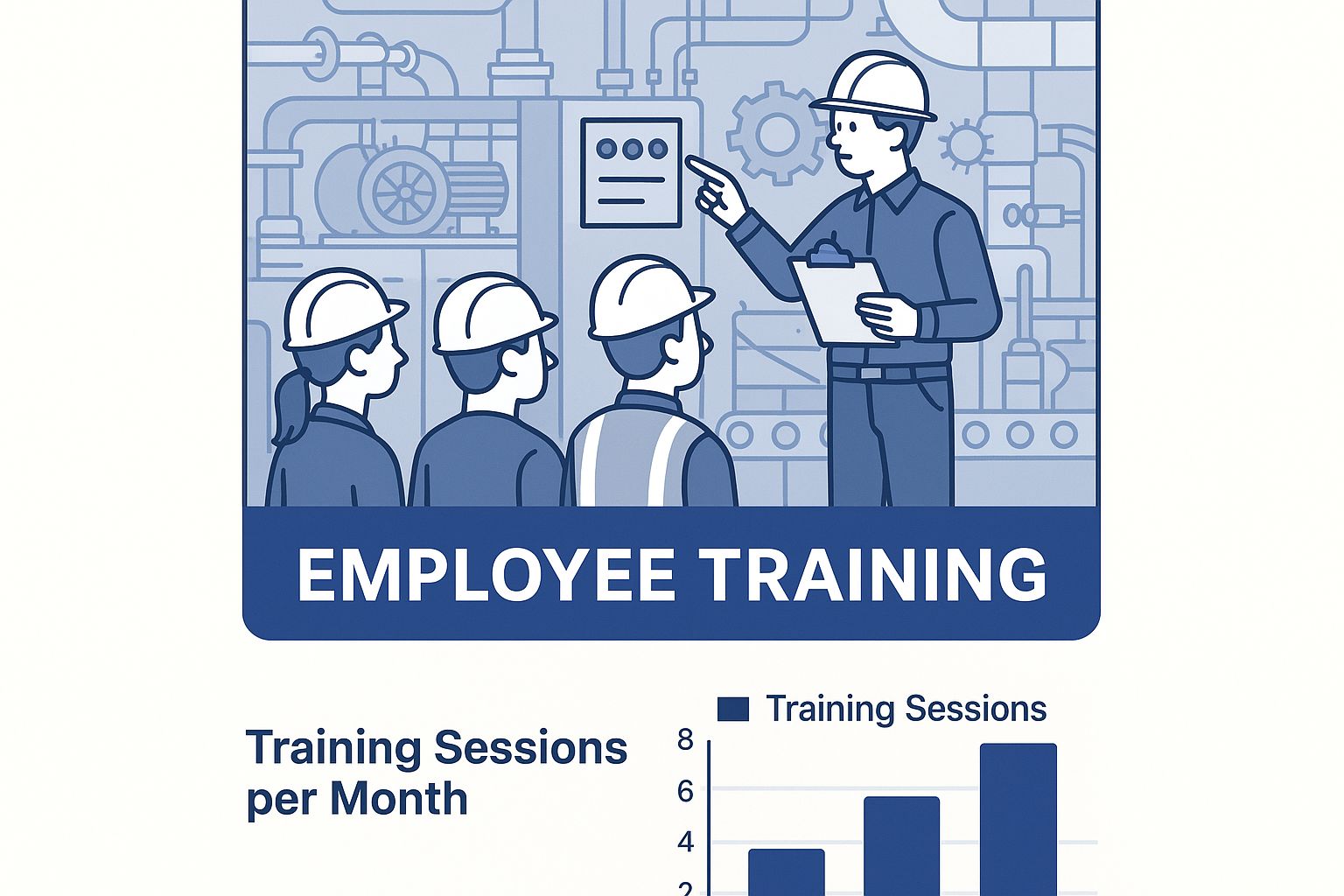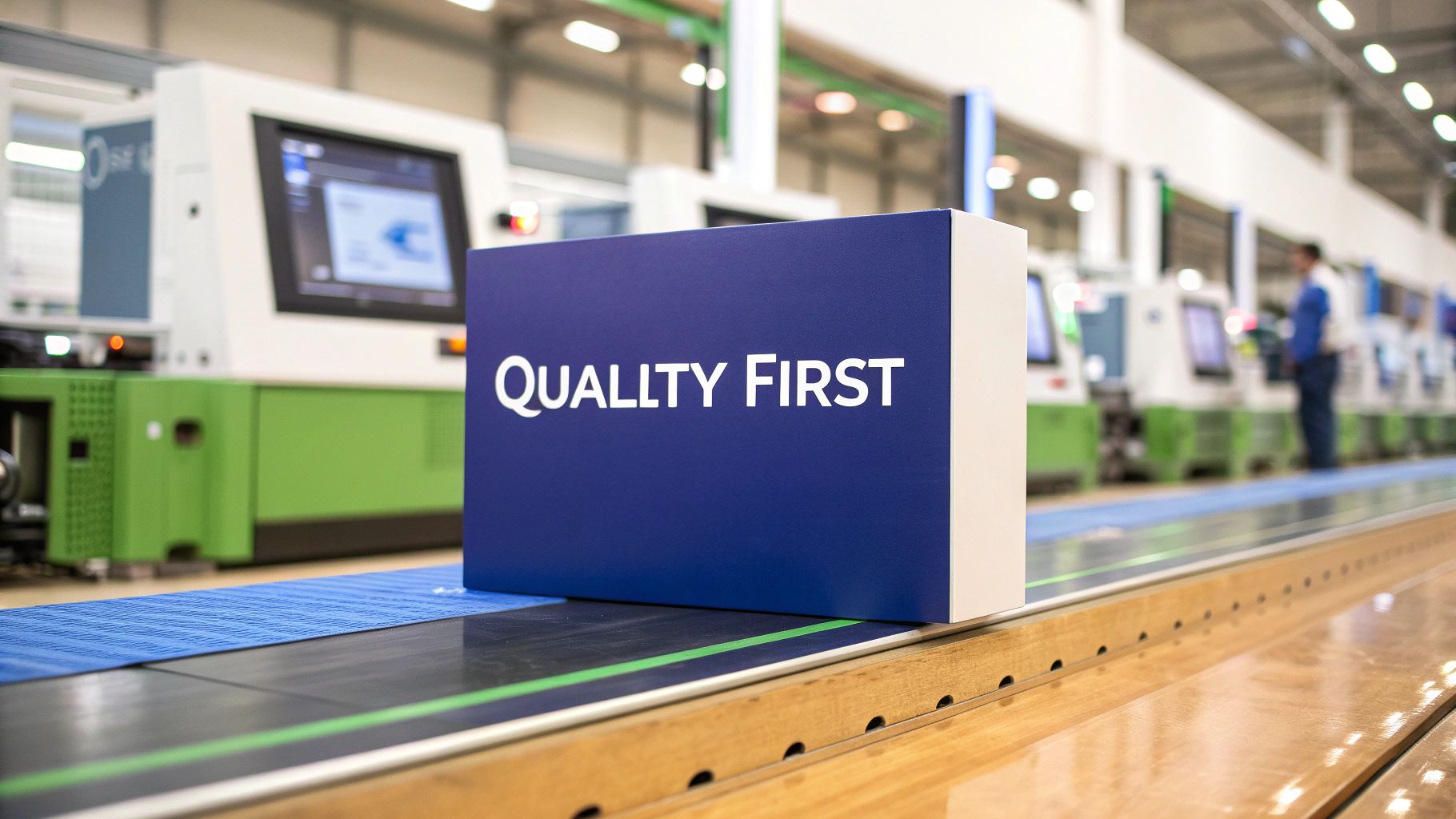Let's be honest, we've all been there. You launch something you're proud of, only to see the support tickets pile up. It feels like you're on a treadmill, constantly fixing yesterday's problems instead of building tomorrow's features.
This is exactly why smart teams stop treating product quality as just another line item on a budget. It’s not an expense to be managed; it’s a direct lever for growth. When you prioritize quality, you slash customer churn, build a brand people trust, and—most importantly—free up your brilliant engineers to innovate.
Why Investing in Product Quality Is a Growth Strategy
Too many companies still see quality as a cost center. It’s a box-checking exercise, a necessary evil that eats up resources without adding to the bottom line. This mindset is not just outdated; it's dangerous. The real cost isn't in building quality products, it's in shipping poor ones.
The damage from a single, nagging bug or a confusing feature creates ripples you might not even see at first.
It all starts with a frustrated user. A buggy app isn't just a minor annoyance; it’s a reason to leave and never come back. Think about it—how many chances do you give a clunky website? Research shows that a staggering 88% of users are less likely to return to a site after a bad experience. That's not just one lost user. It's lost revenue, negative word-of-mouth, and a golden opportunity handed right to your competition.
The Hidden Costs of Ignoring Quality
The fallout from poor quality goes way beyond losing a few customers. When quality is an afterthought, your most valuable people—your engineers and product teams—get stuck in a reactive loop. Instead of building the next big thing, their days are consumed by triaging bug reports and patching up creaky code. This "bug-fix treadmill" is a direct killer of innovation and a fast track to team burnout.
Just look at the downstream effects:
- Skyrocketing Support Tickets: Every bug report costs you time and money, pulling your support team away from helping customers with real strategic problems.
- A Tarnished Brand: In a world of instant reviews and social media callouts, a reputation for being buggy or unreliable is incredibly hard to shake.
- Wasted Marketing Dollars: You spend a fortune to acquire a new customer. Losing them over a preventable product flaw means you just threw that entire investment away.
The biggest hit from poor quality is the opportunity cost. Every hour your team spends on a fix that could have been prevented is an hour they aren't spending on the feature that could delight users and drive real growth.
Flipping the script to a proactive quality mindset changes everything. When you weave quality into every stage of your development process, you're not just preventing defects—you're building a foundation for sustainable growth. You stop putting out fires and start building a product that people genuinely love, recommend, and stick with.
Ultimately, figuring out how to improve product quality is the same as figuring out how to build a stronger, more profitable business.
Defining What Quality Means for Your Business
Before you can even think about improving your product, you have to agree on what "quality" actually means. It’s a deceptively simple word. To your marketing team, it might be a flood of five-star reviews. To an engineer, it’s probably a bug-free launch. If you don't get everyone on the same page with a shared, specific definition, your teams will just pull in different directions. You’ll be busy, but you won't make real progress.
The key is to ditch the fuzzy language and establish concrete Key Quality Indicators (KQIs). These are the specific, measurable metrics that define what a high-quality product looks like for your business and your customers. Think of them as the vital signs for your product's health.
Moving From Vague Goals To Concrete Metrics
So many teams fall into the trap of aiming for something broad like "a better user experience." What does that actually mean? How do you measure it?
A KQI translates that squishy goal into a number you can track, debate, and improve. For instance, "a better user experience" could be broken down into:
- App Load Time: The time it takes for your main interface to become interactive.
- Net Promoter Score (NPS): A direct pulse on customer loyalty and satisfaction.
- Task Completion Rate: The percentage of users who successfully finish a key workflow without hitting a snag.
Choosing the right KQIs is the first, and most important, step in building a quality-focused culture. To get a handle on what to track, you need to understand the essential software quality metrics that offer real insights into performance, reliability, and how users feel about your product.
Building Your Quality Scorecard
Once you’ve identified your core KQIs, the next step is to build a quality scorecard. This isn't just a boring spreadsheet; it's a living document that gets every single department—from product and engineering to marketing and support—focused on the same finish line. A great scorecard gives you an instant snapshot of your product's health.
A truly effective scorecard balances technical performance with customer-focused outcomes.
To give you a clearer idea, here’s how different types of businesses might define quality through their own scorecards.
Key Quality Metrics Across Different Product Types
| Metric Category | SaaS Platform Example | E-commerce Site Example | Physical Good Example |
|---|---|---|---|
| Performance | API response time under 200ms | Page load speed under 2 seconds | Battery life of 10+ hours |
| Reliability | 99.95% system uptime | Zero broken checkout links | Product failure rate below 0.1% |
| Usability | User session duration increases 15% | Shopping cart abandonment rate < 50% | Time to assemble under 5 minutes |
| Satisfaction | NPS score of 50 or higher | 4.5+ star average product reviews | Customer support ticket volume |
As you can see, what matters varies wildly. A SaaS company lives and dies by uptime, while an e-commerce brand is laser-focused on its conversion funnel. Your scorecard has to reflect what’s most critical to your users and your bottom line.
Key Takeaway: A unified definition of quality, backed by specific metrics, is non-negotiable. It transforms quality from a subjective idea into an objective, company-wide goal that everyone can work toward.
Aligning Teams With A Shared Definition
When you have a scorecard, the entire dynamic of your team meetings changes. Instead of arguing over opinions, you start discussing data. A sudden spike in support tickets isn't just a headache for the support team anymore—it's a dip in a KQI that everyone in the company owns.
This shared language and accountability are the bedrock of a healthy quality culture. To dive deeper into creating this kind of unified approach, I highly recommend exploring these quality assurance best practices for building excellence.
Hands-on training is another huge piece of the puzzle, ensuring everyone understands their role in upholding these standards.

When every team member is given clear, practical instruction, they know exactly how their work connects back to the KQIs you’ve all agreed on. That’s how you turn a scorecard into real-world results.
Embedding Quality into Your Development Lifecycle

For far too long, quality assurance has been treated as an afterthought—the final gate you rush through right before launch. This last-minute scramble to squash bugs is not only stressful, but it's also wildly inefficient, expensive, and a perfect recipe for team friction.
To genuinely elevate your product quality, you have to stop treating it as a final hurdle. It’s time to weave quality into the very fabric of your development process from day one.
This is the whole idea behind the "Shift-Left" approach. It’s not about piling on more work; it’s about moving quality-focused activities much earlier in the timeline. When quality becomes a shared responsibility from the get-go, you fundamentally change your entire workflow from reactive to proactive.
From Final Checkpoint to Continuous Process
The old way of handling quality is like inspecting a car only after it has rolled off the assembly line. If you find a major flaw, you have to halt everything, pull the car apart, and start a costly, time-consuming fix.
Shifting left is a smarter approach. It's like ensuring the engine schematics are perfect, the parts are flawless, and the assembly line has built-in checks at every single station.
It's just common sense. Catching a design flaw in a mockup is exponentially cheaper and faster to fix than discovering a functional bug in a live product. A study by the Systems Sciences Institute at IBM really drives this home: a bug fixed during the design stage costs 6.5 times less than one fixed during implementation. Even more staggering, it costs 100 times less than a bug fixed after the product is already released.
This proactive mindset does more than just save money; it transforms how your teams work together.
The goal is to make quality a shared mission, not a departmental silo. Developers, designers, product managers, and testers must all see themselves as co-owners of the final product's excellence. It’s a cultural shift that pays massive dividends.
Think about it. A designer who understands the technical constraints of a mobile app will create UIs that are not only beautiful but also performant. A developer involved in early requirements gathering can spot potential usability issues before a single line of code is ever written.
Practical Steps to Weave Quality into Every Stage
So, how do you actually make this happen? It starts by building specific quality checks into each phase of your development lifecycle.
Design and Requirements Gathering
This is your first, best chance to prevent defects before they even exist. Before any development kicks off, your team should be asking some tough questions.
- Peer Design Reviews: Get designers to present their wireframes and mockups to a group that includes developers and product managers. This cross-functional feedback is invaluable for catching potential usability nightmares or technical roadblocks.
- Requirement Ambiguity Checks: Vague requirements like "make the page load faster" are pretty useless. Define specific, testable acceptance criteria using your Key Quality Indicators (KQIs). A better requirement would be, "The dashboard page must fully render in under 2 seconds on a standard 4G connection."
Development and Coding
Your developers are the first line of defense. This is where you empower them to build quality in, and automation becomes your best friend.
- Unit and Integration Testing: Implement a solid suite of automated tests that run with every single code commit. This acts as a safety net, ensuring new changes don’t accidentally break existing features.
- Static Code Analysis: Use tools that automatically scan your code for potential bugs, security vulnerabilities, and style violations. Think of it as a spell-checker for your code, helping maintain high standards of hygiene.
The CI/CD Pipeline
Your Continuous Integration/Continuous Deployment (CI/CD) pipeline is the perfect place to automate your quality gates. Every time a developer pushes code, an automated sequence should kick off, running all your tests and providing immediate feedback. A broken build means the code doesn’t move forward until it’s fixed, preventing flawed code from ever reaching a testing environment.
Integrating these steps is foundational. For a much deeper dive into the specifics of testing digital products, our complete guide to QA for websites provides an excellent, detailed roadmap: https://bugsmash.io/blog/how-to-qa-website-complete-guide-quality-assurance-testing
Fostering a Culture of Shared Accountability
Tools and processes are crucial, but they’ll fall flat without the right team culture. A true shift-left approach thrives on open communication and shared ownership of the outcome.
When a bug is found late in the game, the conversation often devolves into blame. But when quality is baked in from the start, the conversation shifts to collective problem-solving. This isn't just a philosophical change; it has real operational impact.
Here are a few ways to build this culture:
- Celebrate "Good Catches": When a developer or tester finds a critical issue early, praise them publicly. This reinforces the idea that finding problems early is a huge win for the entire team.
- Cross-Functional Bug Bashes: Before a major release, get people from different departments—marketing, sales, support—to use the product and report issues. This not only uncovers different kinds of bugs but also builds empathy and a shared sense of ownership across the company.
- Make Quality Visible: Display dashboards showing your KQIs where everyone can see them. When metrics like uptime or customer satisfaction are visible to all, they stop being one team's problem and become a shared goal.
By embedding quality into every stage of your development lifecycle, you do more than just reduce bugs. You build a more efficient, collaborative, and innovative team. You finally stop chasing problems and start shipping products that consistently make your customers happy.
Using Technology to Drive Your Quality Initiatives
Trying to manage product quality with manual checklists and human memory alone is like showing up to a Formula 1 race with a horse and buggy. You might eventually cross the finish line, but your competition, armed with modern tools, will have lapped you multiple times.
To truly get ahead, you need to weave technology into the fabric of your quality process. This isn't about chasing every new tech fad. It's about being strategic—picking the right tools to solve real-world problems, automate the soul-crushing repetitive work, and uncover insights you'd never find on your own.
Automation: Your First Line of Defense
Before you even think about more complex tools, the bedrock of any modern quality strategy is automation. Its main job is simple: take over the predictable, time-consuming tasks so your team can focus on the tricky stuff that requires human ingenuity.
A perfect example is automated testing in your CI/CD pipeline. Every single time a developer commits new code, a suite of tests can fire off automatically to check for regressions and confirm basic functionality. This creates an incredibly tight feedback loop. Instead of a manual QA tester finding a critical bug days or even weeks later, developers know within minutes if their change broke something.
This one piece of automation delivers huge wins:
- Blazing Speed: It dramatically shrinks the time between writing code and getting feedback.
- Rock-Solid Consistency: Automated tests perform the exact same way, every time, eliminating human error.
- Unwavering Confidence: Your team can ship updates with more confidence, knowing a baseline of quality is always being verified.
Moving From Reactive Fixes to Predictive Insights with AI
Automation is your defense, but Artificial Intelligence (AI) is your offense. While automation follows a script, AI can sift through mountains of data to spot patterns and make predictions. This is where you graduate from just catching today's bugs to actively preventing tomorrow's problems.
One of the most powerful applications here is predictive defect analysis. By chewing through historical data—old bug reports, code churn, test results—AI models can flag which parts of your codebase are most likely to sprout new defects. This lets you point your testing efforts like a laser, focusing on high-risk areas instead of spreading them thin across the entire application.
It's no surprise that AI-powered quality tools are taking off. Recent analysis shows a planned jump in adoption from a mere 8% to an expected 55% by 2025. Businesses are realizing they need a more proactive approach, and AI’s ability to forecast issues is a massive advantage. You can dig deeper into these trends with this guide to 2025 quality management trends. This isn't just a small shift; it's a fundamental change in how to improve product quality.
Instead of waiting for customers to report problems, you're using data to anticipate them. It's the difference between being a firefighter who reacts to emergencies and an engineer who designs buildings that are inherently safer.
The Power of a Single Source of Truth
As your team scales, information gets scattered everywhere. Feedback is buried in Slack threads, bug reports are logged in Jira, design files live in Figma, and customer emails are stuck in a support inbox. This chaos makes it impossible to get a clear, holistic picture of your product's quality.
This is exactly why a cloud-based Quality Management System (QMS) or a centralized feedback tool like BugSmash is so critical. The goal is to create one central hub—a single source of truth—where every piece of quality-related information is collected, organized, and available to everyone who needs it.
Think about this scenario: A user spots a visual glitch on your site. With a tool like BugSmash, they can capture the issue right on the page, draw an arrow to it, and hit submit. That one piece of feedback, instantly packaged with their browser, OS, and a visual record, lands in a central dashboard for developers, designers, and PMs to see.
This completely eliminates the frustrating "I can't reproduce it" or "Can you send me a screenshot?" dance. A unified system gives you:
- Total Visibility: Everyone from engineering to support sees the exact same information, which sparks better collaboration.
- Faster Resolution: Developers get the full context they need right away, slashing debugging time.
- Richer Data Analysis: With all your feedback in one place, you can finally spot trends and prioritize the fixes that will make the biggest impact.
Technology isn't here to replace your team's expertise; it's here to amplify it. By automating the routine, predicting the future, and centralizing your data, you empower your people to make smarter decisions and build better products, faster.
Creating a Powerful Customer Feedback Loop

Your quality metrics and internal QA processes are a great start, but they only show you one side of the coin. The real judges of your product's quality are your customers. They’re the ones putting your product through its paces in the wild, discovering the friction points and obscure bugs you’d never find in a lab.
Trying to improve quality without their input is like flying blind. If you're serious about figuring out how to improve product quality, you need a system that doesn’t just collect customer insights but turns them into real, tangible improvements. That’s the whole point of a customer feedback loop.
It's a cycle that never stops: gather feedback, sift through it for patterns, act on what you learn, and then—critically—let your users know you've listened. Get this right, and it becomes a powerful driver for both customer loyalty and product innovation.
Diverse Channels for Gathering Insights
One of the biggest mistakes I see teams make is relying on a single feedback channel, like support tickets. Sure, support tickets are important, but they only capture feedback from the most vocal users—those motivated enough to file a report. To get the full story, you have to cast a much wider net.
You'll want a healthy mix of both active and passive collection methods. Think about setting up a few of these:
- In-App Surveys: Use short, targeted pop-ups to ask about a feature right after someone uses it. A simple "How easy was that?" can give you incredibly valuable data.
- User Interviews: Get on the phone with a handful of different users. These deep dives are absolute gold for understanding the why behind their actions.
- Social Media Listening: Keep an eye on mentions of your brand on places like Twitter, Reddit, or LinkedIn. This is where you'll find the raw, unfiltered truth.
- Support Ticket Analysis: Don't just close tickets—categorize them. Are you seeing the same complaint pop up over and over? That’s a massive red flag for your product team.
Each channel gives you another piece of the quality puzzle. When you combine them, you get a 360-degree view of the customer experience that’s impossible to get any other way. To really make this work, you'll need solid strategies to revamp your customer experience feedback loop that turn these raw inputs into a predictable system.
From Raw Data to Actionable Improvements
Collecting feedback is just the first step. The real work begins when you have to turn a mountain of comments, complaints, and feature requests into a prioritized action list for your dev team. Without a solid process, great feedback just gets lost in the shuffle.
This is where a structured triage process is non-negotiable. As feedback flows in, it needs to be tagged, categorized, and sent to one central place. This creates a single source of truth and stops insights from getting stuck in someone's email or a random Slack channel. Our guide on centralized feedback management dives deeper into how getting this organized can completely change the game.
Once everything is in one place, you can start connecting the dots.
A single user complaining about a slow-loading page might be a one-off. But when ten users mention it in a week, you've spotted a significant quality problem that needs to be addressed.
This is what allows you to prioritize effectively. You can start weighing issues based on a few key factors:
- Frequency: How many people are running into this?
- Severity: How badly does it break the experience? Is it blocking a critical workflow?
- Alignment: Does fixing this line up with your current business goals and Key Quality Indicators (KQIs)?
By answering these questions, you make sure your development team is always working on the fixes that will deliver the most impact. This systematic approach closes the loop, creating a cycle where user feedback directly shapes the product's evolution and builds incredible loyalty along the way.
Of course. Here is the rewritten section, crafted to sound like it's coming from an experienced human expert, with a natural flow and style that matches the provided examples.
Unpacking Your Top Questions on Product Quality
Putting a real quality improvement plan into motion always surfaces some tough, practical questions. It’s one thing to talk theory, but it's another thing entirely to navigate tight budgets, tricky team dynamics, and the pressure for quick results.
Let’s get into the nitty-gritty and tackle some of the most common hurdles you'll face on the path to shipping a better product.
How Do We Actually Start Improving Quality With a Tight Budget?
Starting with limited resources doesn't mean you're stuck. In fact, it forces you to be smart and focus on high-impact, low-cost moves first. Forget about shiny, expensive tools for a minute—the biggest wins often come from small shifts in your team's mindset and daily habits.
The best place to begin is by adopting a "Shift-Left" culture. This is fundamentally about changing behaviors, not your budget. Simple things like encouraging developers to do more peer code reviews or just improving your internal documentation are practically free. And they're incredibly effective at catching problems early.
You're also sitting on a goldmine of free data: your existing customer feedback.
Think about it. You already have a constant stream of quality intel flowing in from support tickets, app store reviews, and social media comments. Building a simple process to collect and analyze this feedback costs you nothing but a bit of time, but the insights are priceless. You find out exactly what’s frustrating your users the most.
From there, you just need to prioritize. Zero in on fixing the bugs that cause the most user pain or are tanking your most important business metrics. This targeted approach guarantees your limited resources are spent where they'll make a real, visible difference.
What’s the Best Way to Get Other Teams to Buy In?
Getting everyone else on board with a quality push means you have to stop talking about "quality" as some fuzzy, abstract idea. You need to frame it in terms that matter to their specific goals. Speak their language.
- For the C-Suite: Don't talk about bug counts; talk about business impact. Show them the numbers. Present clear data on how better quality directly cuts down on customer churn, lowers support costs, and boosts customer lifetime value.
- For Your Developers: Frame it as a way to protect their time. Show them how catching issues early means less soul-crushing rework and late-night firefighting. It’s about letting them focus on what they love—building cool new features, not patching old ones.
- For the Marketing Team: Connect the dots for them. Explain how higher product quality leads to glowing reviews, organic word-of-mouth, and a stronger brand reputation they can build killer campaigns around.
This is where the Key Quality Indicators (KQIs) you defined earlier become your secret weapon. They create a shared vocabulary and a common set of goals. When everyone sees how their work directly moves those numbers, quality stops being just "QA's problem" and becomes a company-wide mission.
How Long Until We Actually See Results?
You’ll see results come in waves. Some improvements will pop up almost immediately, while the deeper, more impactful changes will take a bit more time to surface. The trick is to track both, so you can show early momentum and keep everyone motivated for the long haul.
You’ll likely see some early wins within just a few weeks of implementing better testing or more consistent peer reviews. These are things like a noticeable drop in critical bug reports. Think of these as your leading indicators—the first green shoots that prove your new processes are taking root.
The bigger culture shifts and improvements in your lagging indicators—things like your Net Promoter Score (NPS) or customer churn rate—take longer to move. These metrics typically show meaningful change over several months, as the cumulative effect of a higher-quality product slowly builds trust and loyalty. Patience and consistent tracking are everything here.
Turning all those valuable customer insights into actual product improvements requires the right setup. Instead of juggling messy spreadsheets and endless email threads, BugSmash gives you a single, central hub for all your product feedback. Let your team focus on building amazing things, not chasing down screenshots. See how you can streamline your feedback loop.




